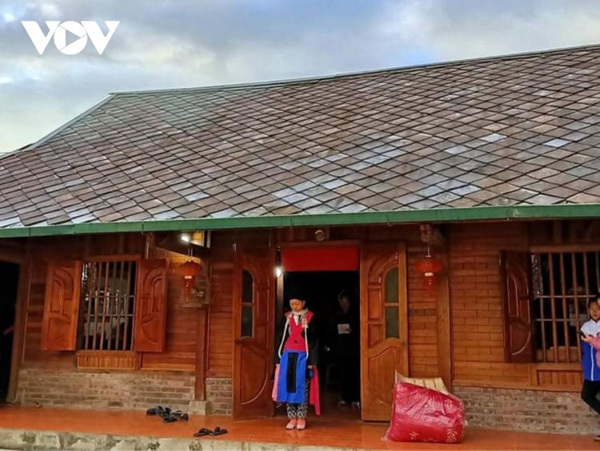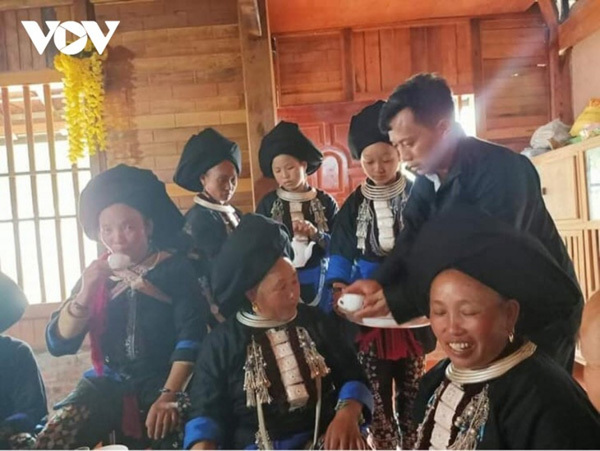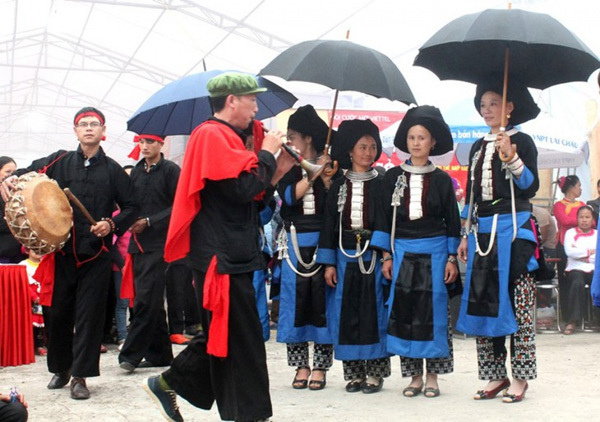 |
| A bride stands outside the groom's house waiting for a ritual to erase all bad luck for her. |
The Dao Khau wedding takes place over three days. On the first day they prepare necessary things at the groom’s house. The second day is for the bride procession. The wedding ends early on the morning of the third day. On the night before the bride procession, people gather at the groom’s house for an all-night party.
“The midnight party includes the groom’s parents and relatives, representatives from the bride’s family, the matchmakers, and a shaman,” says Tan My Dao of Sin Ho District.
”The families of the groom and the bride review the things they will bring to the bride’s house, such as cash, jewelry, clothes, and other gifts. When everyone is happy, they accept each other as family members, and change the way they address each other.”
The next morning, a musical group plays joyful melodies to accompany the groom’s delegation to the bride’s house. The delegates include four or five well-spoken people, a man carrying cigarettes, two girls carrying a tray of tea cups and a thermos of boiling water, three or four men carrying a bench, and a little boy and a girl who will carry the bride’s belongings, including a small blanket.
Before departing, the shaman holds a ritual to inform the ancestors of the bride procession. He burns incense and places offerings such as a chicken, fresh water, and liquor on the altar to encourage the deities and ancestors to make everything go smoothly.
The delegates kneel in front of the altar to pray for health, no obstacles on the way, and safe arrival at the bride’s house, as well as a safe return to the groom’s house.
When they finish the ritual, the loud music starts up. A clarinet player leads the procession. They stop at a distance from the bride’s house and play more loudly to signal the bride’s family to bring the bride out.
 |
| A Dao Khau couple invites tea to their relatives and guests. |
When the bride comes, they sit down on the bench to drink tea and assign people to carry the bride’s things.
“The clarinet player leads the musical group. They walk three counter-clockwise circles which symbolizes tying and three clockwise circles which symbolizes untying. The action indicates the groom’s respect for the bride’s family,” says Cheo A Xoang, a clarinet player in Phang Xo Lin Commune.
”Finally, they bow their heads to greet the matchmaker who also bows his head in response and signals the delegation to follow the musical group back to the groom’s house,” he adds.
On the way home, the musical group must play continuously with no interruption. They checked the path the previous day to clear any obstacle.
Arriving at the groom’s house, the delegation stops in the front yard. The bride stands alone at the main door, facing out. The shaman conducts a ritual to ask the deities and ancestors to erase all bad luck for the party, particularly for the bride.
When the shaman finishes the ritual, a woman who has a happy family that includes both sons and daughters, spreads a mat in the main hall, places the bride’s blanket on the mat, and leads the bride to sit on the blanket facing the altar.
”A man then hangs a red cloth on the main door to signal that the house has a new daughter-in-law. The shaman completes a spiritual ritual to make the bride an official family member so their ancestors will bless her,” says shaman Cheo Lao U of Sin Ho Town.
A lucky woman takes the bride and two maids to the wedding room. She waits until a propitious moment to go out and perform a ritual at the ancestral altar.
At midnight the wedding party begins. The groom’s parents thank the relatives and villagers for attending the wedding. Young people in beautiful clothes enjoy the meal and sing love duets to congratulate the newly-weds.
Source: VOV5

Clarinet of the Dao Khau
The Dao Khau ethnic group in the northern mountainous province of Lai Chau have a set of traditional musical instruments, of which a clarinet is the most difficult instrument to play.

Wedding customs of the Ha Nhi ethnic group
Expressing one’s love through music, running away to the beloved’s house, and scaling money on the wedding day are some of the unique wedding customs of the Ha Nhi ethnic people in Muong Te district, Lai Chau province.